DOUG'S GAMING PAGE
Notable Peripherals
This is a short list of some of the more notable PC peripherals that I've owned over the years, and why they stick in my memory. In my main timeline of PCs I mention some peripherals specifically, such as external modems, which I do not duplicate here.
HP Deskjet 500c
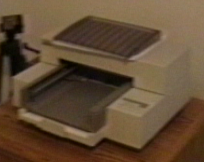
The integrated thermal printer in my Panasonic Sr. Partner is still working today, so it's my most memorable printer. That one aside, the only stand-alone printer I consider memorable was the first color inkjet that I owned, the HP DeskJet 500c. This printer was introduced in the late 80s at a price of over a thousand dollars, but I did not own one until late 1993 when the price had dropped to about $350 -- still an astronomical sum for a printer, by today's standards. My parents bought it for me while I was in college, and I think they may have bought it from a family friend or co-worker. This printer had a remarkably long life, as the photo you see here was taken around ~2000 in my first house. I have no idea how many thousands of pages I printed on this guy through college and into my early career.
Ergonomic Keyboards
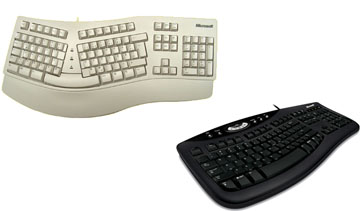
In the late 90s I bought a Microsoft Natural keyboard, which I never quite got used to. It did reduce hand fatigue slightly for me, and probably made me a better typist because of the hard L/R split, but I did not like it near as much as its successor -- the Comfort Curve 2000. I think I owned (and wore out) at least two Microsoft Comfort Curve keyboards between 2000 and ~2011 when it was discontinued for the Comfort Curve 3000, which I did not care for. The newer model did not have the hard split and did a much better job of aligning my hands properly.
Mechanical Keyboards

In July of 2013 I bought a SteelSeries 6Gv2 mechanical keyboard with red switches, which has served as my primary keyboard since. In January of 2017 I picked up a Unicomp buckling spring keyboard, shown above. Unicomp is the only keyboard maker still producing a buckling spring keyboard, and their product faithfully replicates the heft and click of the old IBM Model M keyboards from the 1980s. Almost everything about the keyboard, save for the color scheme and USB plug, is a replica of the old IBM AT keyboards. It's too stiff for me to play games on, so I still use the SteelSeries 99% of the time. But once in a while I hook up the Unicomp for typing. In 2019 I picked up a Razer Huntsman, which has short-throw, clicky switches that are even better for typing.
Joysticks
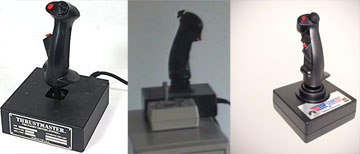
In the foreground of the center image above is an actual picture of the first joystick I ever owned, which I bought some time in the late 80s and kept through the mid 90s. It was a simple joystick with two buttons and two axis trim controls. In the late 80s you had to fill an expansion slot on your PC with a card that provided "game ports" that you could plug a joystick in to. Later, sound cards started including a multipurpose serial game port that could be used for joysticks, or MIDI devices. Also shown above on the left and right are the Thrustmaster and Thrustmaster Top Gun joysticks, the only other two joysticks that I owned. At one point I was playing Quake using a joystick, and not badly either. I got pretty good using the Thrustmaster's hat switch to flick-aim, as absurd as that sounds now. Today I'm a keyboard+mouse warrior, but I do have an XBox 360 controller that I use when required. I haven't owned a joystick since about 2004 -- but they were indispensable back in the day for flight simulators.
Mice
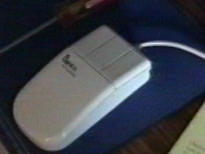
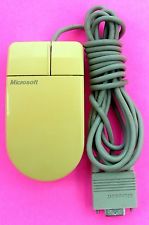
Shown above (left) is the first 3 button mouse I ever owned, circa 1996. I have no idea what brand or model it is, and there's really not much to say about it. Back then, mice had an internal ball that rolled on your mousing surface -- and it got loaded up with dirt and hair, requiring you to clean it every so often. Above on the right a picture of a vintage Microsoft mouse with the left button larger than the right -- who didn't own one of those? The first mouse I owned with a scroll wheel came with the system I bought in 2000. The very first mouse that I ever owned (which I bought to play Populous) was a "Radio Shack Serial Mouse" for my Sr. Partner IBM clone. It didn't come with a driver, and I had to copy one from a friend. Every time I wanted to use it I had to boot from a special system disk that loaded MOUSE.COM into the PC's memory. Today, even your BIOS has a mouse driver and a graphical interface to go with it. Now that's progress.
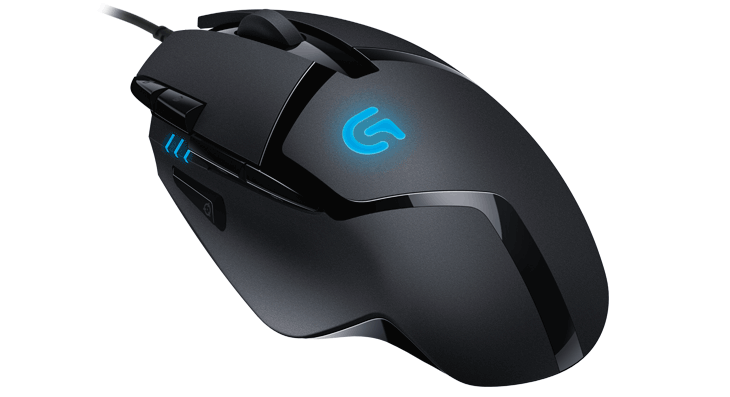
I've been using a Logitech G502 for a couple years now, and I hope it hangs in there because I really like it. Prior to that I had a G402 and another 400 series mouse from Logitech; the first one wore out and they replaced it free of charge. I have experimented with other mice, namely some models with adjustable weighting, but none of them have been anywhere near as comfortable as the G502/G402. The way Logitech stands behind their peripherals really appeals to me too.
Other Peripherals
I mention a couple of speaker systems in my main PC timeline, along with headsets such as the Microsoft Life Chat LX300 that I really like. Not too much else is worth mentioning. I've owned other oddball peripherals over the years such as a tablet+stylus input system, which I can't remember the details of. I owned that thing when I was really into drawing programs like Deluxe Paint and Disney Animation Studio. I mentioned the Video Blaster that I owned in my main PC timeline as well, which was a video capture and genlock board. One of my high school friends had a genlock for the Amiga 500 years before I got the Video Blaster, and it worked better. What I really wanted, back in those days, was a Video Toaster. Even a fairly modest PC these days has capabilities far beyond those pioneering systems/peripherals. Even phones these days can capture and edit high quality digital video at resolutions you didn't even dream of back then.
back to hardware page






